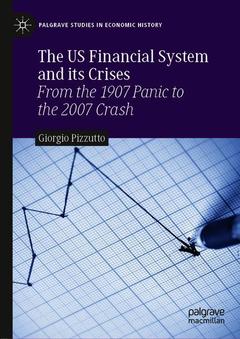The US Financial System and its Crises, 1st ed. 2019 From the 1907 Panic to the 2007 Crash Palgrave Studies in Economic History Series
Auteur : Pizzutto Giorgio

Looking at the precedents set by the panic of 1907 and the Great Depression in America, this book investigates the causes of the 2007-2008 financial crisis. Pizzutto examines the effects of monetary policy, as well as of expanding and contracting financial cycles, in order to analyze the breakdown of the money market and capital market circuits. Not only exploring the impact of the Federal Reserve and central banking on monetary policy, he also analyzes the role of non-bank financial intermediaries.
How can monetary policy resolve the instability of the US financial system? How can financial intermediation work effectively? This timely book highlights how historical lessons can be used to avoid the next financial crisis.Chapter 1: Introduction.- Chapter 2: The US financial system from the National Banking Act to the crisis of 2007.- Chapter 3: The birth of the Federal reserve and its monetary policy.- Chapter 4: Non bank financial intermediaries and the crisis of 1929.- Chapter 5: The Great Depression.- Chapter 6: The money market after the second world war: securitization and the role of dealers.- Chapter 7: Monetary policy, spread compression and the house market.- Chapter 8: The money market, the collateral market and the crisis of 2007-08.- Chapter 9 Conclusions.
Giorgio Pizzutto is Professor and Head of the Department of Economics, Management and Quantitative Methods at the University of Milan, Italy.
Uses historical examples to understand financial crises
Compares the Great Recession with the panic of 1907 and the Great Depression
Examines the birth of the Federal Reserve and its aims
Highlights the role of non-bank financial intermiediaries and the crisis of 1929
Investigates the money market after the Second World War
Date de parution : 04-2019
Ouvrage de 219 p.
14.8x21 cm
Disponible chez l'éditeur (délai d'approvisionnement : 15 jours).
Prix indicatif 94,94 €
Ajouter au panierThèmes de The US Financial System and its Crises :
Mots-clés :
US Financial System; Financial crises; American economic history; Federal Reserve; History of Finance; US monetary policy; The Great Depression; The Great Recession; Non-bank financial intermediaries; World War Two economics; Securitization; Dealer financing; The collateral market; Spread compression; Central banking history; History of financial markets; Panic of 1907; National Banking Act; Housing Market Crash; banking



